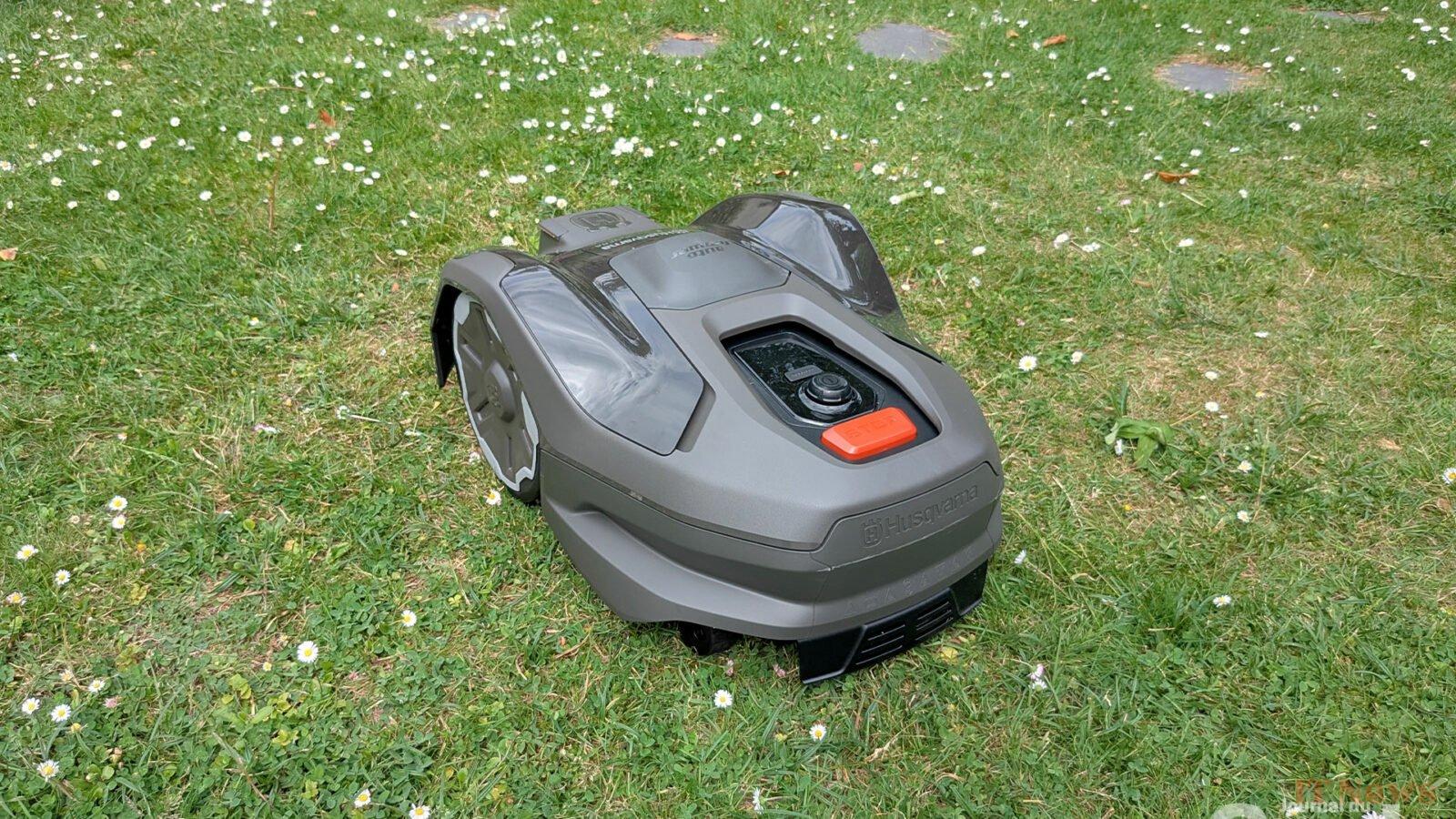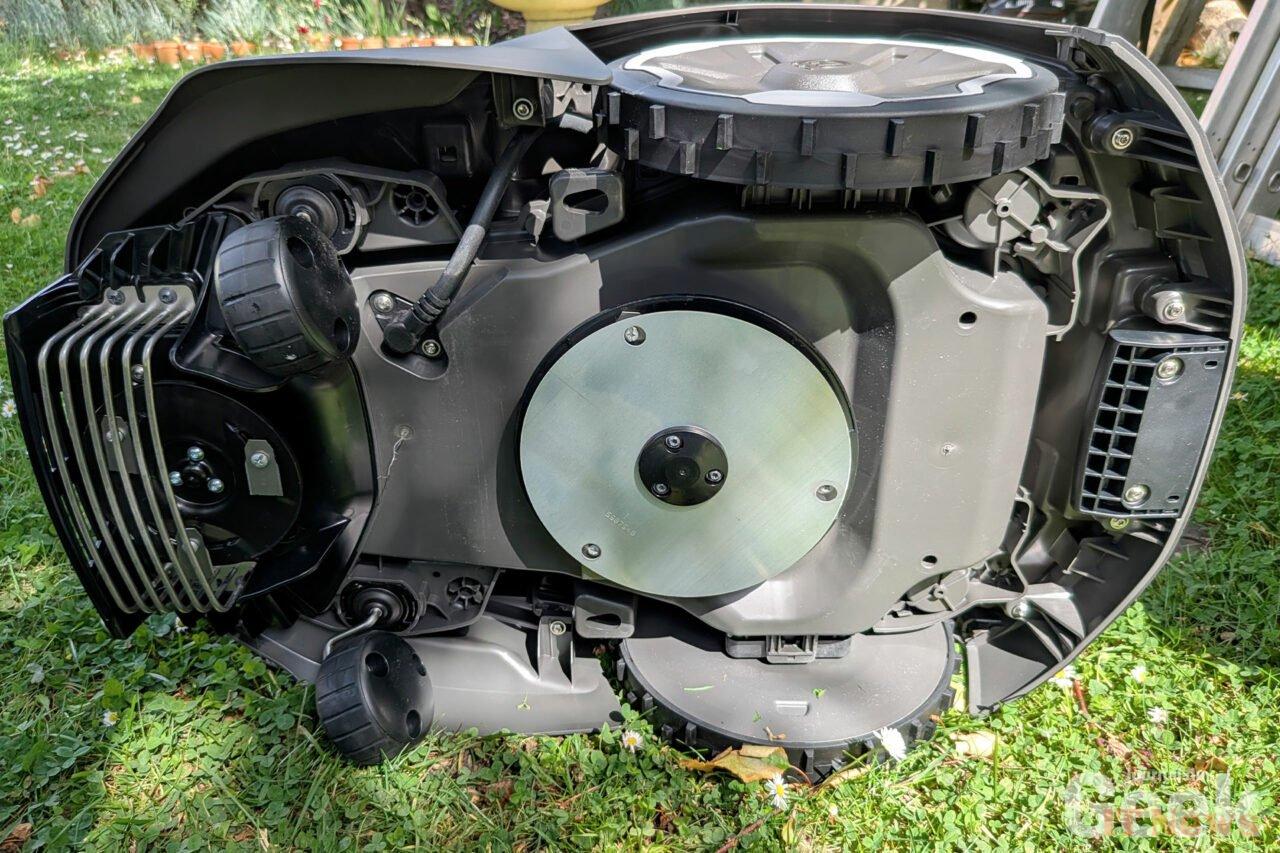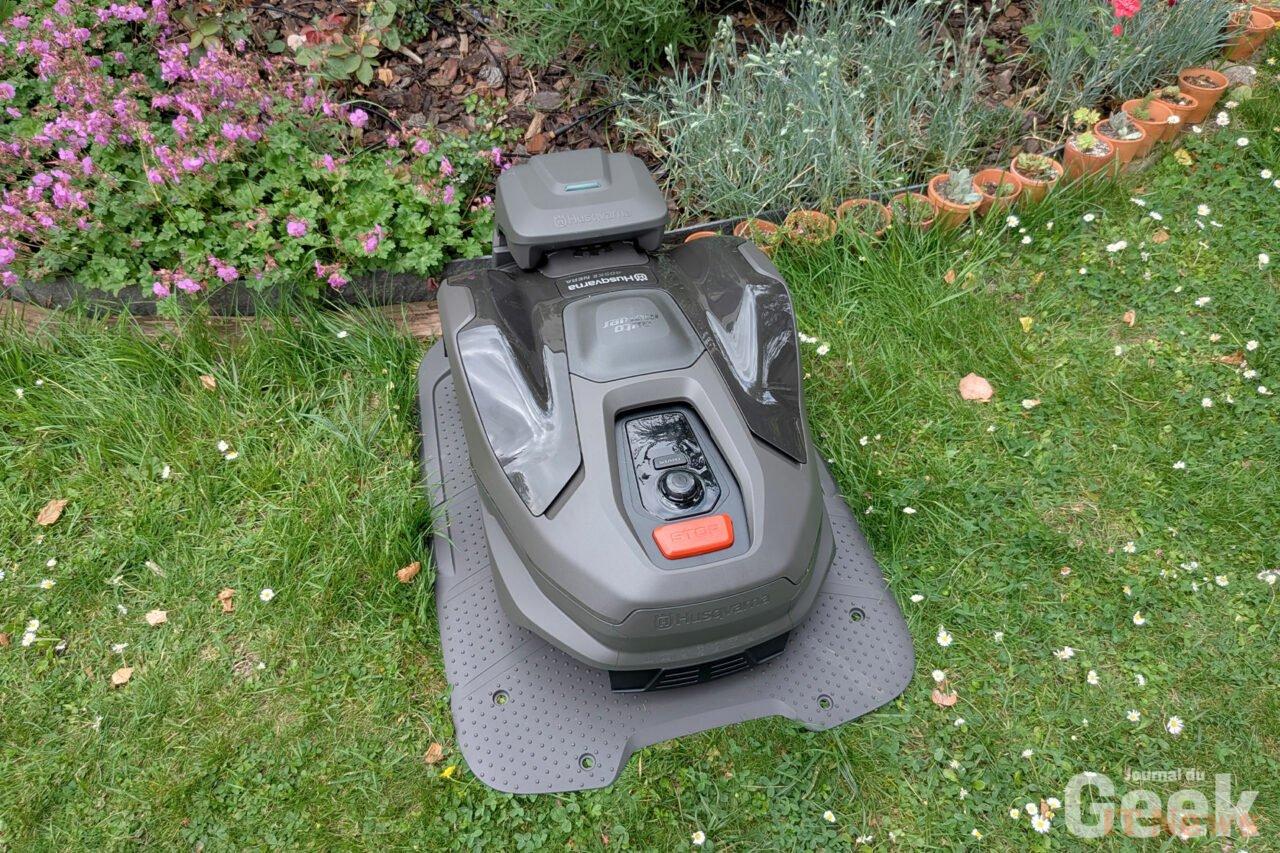The high-end Husqvarna Automower 405XE NERA offers simplified installation thanks to satellite guidance (EPOS technology) and brings its share of innovations: fully virtual boundary management, connected application, EdgeCut function for edges, obstacle avoidance sensors, etc. We evaluated it in the field for several weeks to compare these promises with everyday reality.
Wireless installation: the EPOS revolution in practice
The major change brought by the Automower 405XE NERA is the abandonment of the traditional boundary wire, replaced by an RTK satellite navigation system called EPOS (Exact Positioning Operating System). Concretely, this means that instead of having to bury a wire all around the lawn, the mowing area is virtually demarcated in the mobile application. Husqvarna offers two methods for EPOS guidance: either use the correction data provided via the Husqvarna Cloud (internet connection), or install an RTK reference station locally in the garden.
In the first case, the mower receives satellite corrections via the 4G mobile network (or via Wi-Fi depending on the model) to locate itself with an accuracy of approximately 5 cm (it does not require any additional subscription, Husqvarna provides this cloud data at no extra cost).
In the second case, if your land is poorly covered by 4G, an EPOS RS1 reference station can be installed, which then ensures even finer accuracy, of around 2 cm, while being completely independent of the network. This reference station is recommended for optimal performance, for example to make the EdgeCut edge mowing function more reliable, but it represents a significant additional investment.
Note that it is even possible to combine approaches: the system accepts a "hybrid" installation combining wireless zones and portions with physical cable in areas where satellite reception is too poor (narrow corridors, under large trees, etc.). This flexibility ensures that no complicated area of your garden is unreachable, even if it means using a piece of wire in problem areas.
How does the installation work in practice?
First, you need to position the robot's charging station around the perimeter of the lawn. Husqvarna recommends a clear location, ideally a few meters from any vertical obstacle and in the open air (avoid placing it under a tree or against a wall). Once the base is fixed to the ground and powered, the robot is placed on it and the Automower Connect app is launched. The initial pairing is done step by step using the smartphone: the new robot (NERA model) is added to the app, then the instructions are followed to connect it and to declare the charging station. On our test unit, we had to restart the charging station once for it to be detected correctly, but the entire pairing process was simple and well-guided.
Next comes the key step: mapping the terrain and creating virtual boundaries. This is probably the most delicate operation of the wireless installation, and it takes the necessary time. The app prompts you to define a docking point: by leaving its base for a few meters, the robot virtually records the position of its charger, which will serve as a reference point for returning. Then, we move on to defining the boundaries of the area to be mowed. The trick is to control the robot manually via the smartphone, like a small remote-controlled car, by making it go around the garden.
We walked the perimeter of the lawn clockwise, ensuring that the robot's left edge followed the desired boundary as closely as possible. At regular intervals (approximately every 30 cm), we recorded a GPS point by pressing a "+" button in the app. These points together form the digital contour of the land. The more we multiply them, the more precise the map will be, so we shouldn't try to complete this too quickly. We took care to include in the map any flowerbeds or trees to be excluded by going around them in the same way (it is also possible to define "exclusion zones" separately via the interface, very useful for temporarily prohibiting access to a part of the garden). In the end, after a few tests and adjustments, we obtained a faithful virtual map of our lawn. The positioning accuracy proved to be interesting: the manufacturer announces a margin of error of only 2 to 3 cm with cloud correction, which our observations generally confirm. It's reassuring to see the robot stop exactly where you drew the line in the app.
Features of the 405XE NERA
The Husqvarna 405XE NERA incorporates the strengths that have made the brand's Automowers famous, while introducing new features exclusive to the NERA series. Physically, it's a robot that's not so compact but well-finished, sporting a sober dark gray design. Under the hood, there's a cutting disc with three pivoting razor blades (Husqvarna standard) that ensures a fine and even mulching cut. The cutting height is adjustable via the app between 20 mm and 55 mm, which corresponds to a fairly short lawn to medium-high grass. In practice, we often kept the cut around 35 mm for an optimal aesthetic result at home. A small motor adjusts the height on command, so you can change the cut remotely without having to manually touch the mower.
The 405XE NERA is an “X-line” model at Husqvarna, synonymous with high-end. As such, it has full connectivity (Bluetooth, Wi-Fi and especially 4G) allowing you to control and monitor it remotely in all circumstances. During our test, the mower remained permanently connected to the mobile network thanks to an integrated eSIM, we were able to follow its movements in real time on the app and receive notifications, even when we were far from home. The Automower Connect app proved useful for starting or stopping mowing remotely, adjusting settings (operating times, cutting heights, mowing zones) and being alerted of the slightest problem. In addition, the Automower 405XE NERA is compatible with common home automation ecosystems: it can be integrated with Amazon Alexa, Google Home, or use IFTTT to create custom automations. For example, we were able to ask Alexa about the mower's status or send it back to its base with a voice command.
EdgeCut: finally efficient edge mowing
One of the key innovations of this generation is the EdgeCut function, designed to address one of the criticisms often made of robot mowers: their difficulty in properly mowing edges along walls, fences, or flowerbeds. Husqvarna provides an ingenious solution here with a second, smaller cutting deck placed at the rear of the robot. Specifically, during our tests, we saw the 405XE NERA activate this small additional disc when it was following a border: it mows the edge of the lawn very closely, much more closely than a conventional robot. The result is convincing. On a driveway bordered by paving stones, for example, the robot managed to cut the grass almost flush with the paving stones, where there is usually an uncut strip of a few centimeters that needs to be finished with an edger. Here, the use of an edger becomes less important, only for a few corners or high edges.
Overall, EdgeCut greatly minimizes the need for manual touch-ups on the edges: it's a real time saver and a plus for aesthetics. Note that this EdgeCut technology appeared on larger models last year, and is now present on the 405XE (as well as the smaller 305E). This is a significant differentiator from the competition, as few robots on the market have such an effective edge trimming feature.
A smarter, more careful robot mower
The 405XE NERA is packed with sensors that improve its navigation and safety. First, it incorporates a GPS module not only for EPOS guidance but also to optimize its movements. This GPS allows the robot to map the areas already mowed and ensure even coverage of the lawn, avoiding forgetting areas (and also avoiding always going over the same spots to avoid compacting the grass). In EPOS mode, the robot is even capable of adopting a systematic mowing trajectory rather than a random one, i.e., following straight parallel lines, much like a lawn tractor would, which improves its hourly efficiency by around +50% compared to classic random mowing. We tested this strip mowing on our lawn: the result is a striped lawn, with no forgotten areas. Husqvarna, however, had the good idea of varying the orientation of the lines from one cycle to the next, precisely to avoid marking the ground with repetitive wheel tracks. In addition, if your garden has narrow passages, the robot automatically knows how to switch back to random mode in these tight areas to squeeze through when it can't. In the end, navigation is both methodical in large spaces and clever in difficult corners.
Another new feature of the 405XE NERA: a front radar sensor for obstacle detection. This radar allows the mower to slow down when approaching an object and go around it instead of simply hitting it with its bumper. In our lush garden, we clearly saw the difference: the robot slows down significantly before brushing against a flower pot left on the lawn, and changes direction smoothly, whereas an old Automower would have simply touched it lightly and then moved on. This reduces the risk of unexpected stops and wear on the robot. Be careful, however, this system has its limits: very small objects or very fine obstacles (such as a plant stake, a garden hose) were not always detected during our tests, the robot sometimes hit them gently before reacting. Similarly, radar detection does not completely prevent some light contacts, but overall we did not notice any violent impacts or blockages due to an obstacle thanks to this device.
Mowing efficiency
Once the configuration is complete, it's time to mow! We launched the Automower 405XE NERA on a lawn of approximately 200 m² (in total) which was quite complex, including several flowerbeds and generally uneven ground. From the start, the cutting quality impressed us: the grass was cut very finely and evenly. Thanks to its continuous mulching principle (the robot passes almost every day), the lawn always remains green and clean, without accumulation of grass clippings, the latter being so small that they fertilize the soil discreetly.
We used it in both dry weather and light rain: the mowing remains effective and the robot does not seem to be affected by humidity (Husqvarna Automowers are known for working in all weather, and this model is no exception, the electronics are well protected and the chassis can be rinsed with a hose for cleaning).
In terms of autonomy, the 405XE NERA does well since we clocked around 60 minutes of mowing per charge, the mower then returning on its own to recharge for about 60 minutes. This cycle is quite fast: roughly, in just over an hour it is able to mow a good third of our 200 m² area. Spread over the day (and night if necessary, since it can chain cycles 24 hours a day), this allows it to easily cover the entire area several times a week. Note that the theoretical maximum surface area of 600 m² announced by Husqvarna seems to correspond to use in classic random mode. By using the systematic mowing made possible by EPOS to optimize trajectories, it is possible to achieve up to 900 m² of effective coverage. The Lithium-Ion batteries recharge quickly and the charging system is intelligent: the mower adapts its mowing frequency and mowing time according to the season and the growth of the grass (it can mow more during spring growth, then ease off in summer).
One point that particularly struck us was the quietness of this robot. Husqvarna announces a noise level of around 58 dB(A), and indeed, the 405XE NERA is very quiet. A few meters away, you can barely hear a slight mowing noise. It is entirely possible to operate it at night without disturbing the neighborhood – especially since its LED headlights (adjustable) can be turned off or set to low intensity mode to avoid attracting attention. This quiet operation is a significant advantage compared to noisy thermal mowers, and even compared to some lower-end competing robots.
The Automower Connect app is rich in features, but its interface takes a little getting used to. You can tell that Husqvarna has added many options over the years, which can make some menus unintuitive at first glance. On a daily basis, however, once the settings are made, we interact little with the interface except to monitor the progress or start/stop mowing. During our tests, we received two OTA (firmware) updates for the robot, a sign that the product is evolving and that fixes/optimizations are being made.
One small drawback: these updates can take time! The robot must be stationed and connected, and the download and installation took nearly an hour in one case. In addition, the app did not always show the robot's exact position in real time on the map: we sometimes saw the mower located a few meters from its actual position, or the app indicated a fanciful distance to the reference station. These are details that could be improved, certainly linked to the youth of EPOS technology.
Furthermore, once or twice, the robot remained stuck for a few minutes when leaving its base, displaying "searching for satellites" indefinitely when it obviously already had its position (since we could see its icon well placed on the map). We had to press STOP then restart mowing for it to decide to start immediately. This kind of micro-bug turned out to be quite rare and may have been corrected later via updates.
Advantages and disadvantages
Let's start with the advantages. The first is obviously the EPOS wireless installation. For a user who dreads the chore of laying cables (digging trenches, pulling meters of wire around the garden), Husqvarna's solution is a real relief: you configure everything from the sofa, and if you decide to change the mowing area (enlarge the lawn, move a flowerbed), you simply virtually redraw the boundary in the application. This flexibility really works well in most gardens.
The second big advantage concerns the quality of mowing and lawn maintenance. The Husqvarna 405XE NERA delivers an exemplary cut: the lawn is always short and healthy (fine mulching), without visible wheel marks thanks to a well-thought-out navigation pattern. The EdgeCut function significantly improves the finish on edges, which reduces the time spent manually fine-tuning. Another notable aspect is that the mower works silently and autonomously without requiring your constant intervention.
The third strong point lies in the connectivity and intelligence of the device. The app allows for full remote control, integration with the connected home, and the sensor system (GPS, radar) gives the 405XE NERA real adaptability. During our test, we appreciated receiving an alert on the smartphone when the robot got stuck on a forgotten tool: we could then locate it immediately and intervene. In the event of an attempted theft, the GPS tracking and the integrated alarm also provide reassurance (the robot can be permanently geolocated and locked with a PIN code).
Let's now discuss the drawbacks or limitations we've identified. The main pitfall of the wireless EPOS solution is that it's highly dependent on terrain conditions and the quality of the satellite signal. If your garden is very steep, surrounded by high walls or large, dense trees, there may be local GPS signal loss. Husqvarna has considered allowing the addition of a cable in these areas, which mitigates the problem, but it goes somewhat against the "100% wireless" concept. It's important to keep in mind that each configuration will be different. Furthermore, the initial installation, while physically easier than a wired setup, requires a minimum of care and technological skill. Controlling a robot with your smartphone to map the terrain isn't rocket science, but it does require time and precision. For a user who is not very comfortable with apps or connected gadgets, this can be intimidating (even if the Husqvarna dealer can offer the installation service, at an additional cost). As such, the app could offer slightly more in-depth tutorials to guide the user step by step; currently, you have to refer to the PDF guide or the brand's explanatory videos to fully understand the mapping tips.
On a purely hardware level, the cost of the whole thing can be a deterrent. The Husqvarna 405XE NERA is priced at around 2199 euros, which positions it as a premium model. At this price, the EPOS plug-in (the GPS module to be installed in the mower) is normally included, but the RTK reference station, if you need it, is sold separately for around €800 to €1,000 extra. This gives you a substantial budget for mowing 600 to 900 m², whereas conventional wired robots covering the same area cost less than €500. That said, Husqvarna is not alone in this niche: in recent years, other manufacturers have launched their cordless models (for example Segway with its Navimow, Ecovacs, Dreame, or Worx which is testing an approach using artificial vision).
Availability and price
Husqvarna Automower 405XE NERA with cordless technology is available at a price of 2648 euros.





0 Comments